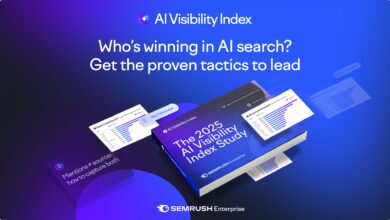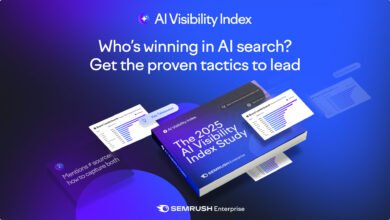AI Search Pushes Brands Beyond Google: The New Channel Strategy

▼ Summary
– Traditional SEO is becoming less effective as AI search engines and other channels like Reddit increasingly provide instant answers, reducing clicks to websites.
– AI Engine Optimization (AEO) is emerging as a new strategy to optimize content for large language models by focusing on semantic topic depth and natural language queries.
– Effective AEO requires choosing topics that build strong semantic associations and creating comprehensive content clusters to establish authority within a product category.
– Content must be designed for machine readability with accurate, structured information, standalone “chunks,” and entity associations to improve retrieval by AI systems.
– Brands must diversify their channel strategy, engage buyers in real-time, partner with trusted creators, and use AI to scale content production to meet audiences where they are.
Imagine a scenario where your content appears prominently in search results, yet the number of people actually visiting your website has plummeted. Data indicates that a majority of Google searches now conclude without a single click, as consumers increasingly turn to sources like Google’s AI Overviews and community forums for immediate answers. This shift represents a fundamental change in information discovery, forcing brands to rethink a strategy that once relied heavily on a single channel.
The predictable returns from traditional SEO are diminishing. Artificial intelligence now provides personalized, on-demand knowledge across a wide array of platforms, and users are actively exploring alternatives to conventional search engines. This evolution means that depending solely on organic search is no longer a viable strategy. To remain visible, brands must distribute their content across the diverse digital landscapes where their potential customers are spending time. As AI search gains traction, optimizing content for both people and the large language models (LLMs) powering these tools becomes critical.
Understanding AI Engine Optimization (AEO)
The integration of AI into daily business operations has accelerated dramatically. Organizational adoption has surged, fundamentally altering how people find and consume information. A curious paradox has emerged for businesses: improved search rankings and impressions no longer guarantee website traffic. This is because AI engines are increasingly the starting point for product discovery.
It’s important to recognize that the underlying steps a buyer takes haven’t changed. They still identify a problem, seek a solution, evaluate options, and make a purchase. What has transformed are the channels guiding them, with AI search now heavily influencing the initial phases.
Traditional SEO was built around securing a top spot on a search engine results page (SERP). Content was crafted to answer simple queries, expecting users to conduct their own research by clicking through multiple links. In contrast, AEO focuses on having your content selected as the definitive answer within an LLM interface. This requires developing material that satisfies complex, conversational questions and can withstand follow-up inquiries.
Selecting Topics with Strategic Foresight
Success in AEO hinges on two pillars: strategic topic selection and intent-driven content design. AI engines use sophisticated models to understand the connections between words and ideas. To succeed, brands must build strong semantic associations between their content and the broader product categories they operate in.
For instance, a company selling project management software should create content that covers not just “project management tools,” but also dives deep into adjacent areas like “resource allocation,” “workflow automation,” and “team collaboration best practices.” This approach helps AI systems view the brand as an authority within the entire semantic field.
To achieve an effective topic strategy, focus on claiming and dominating a conceptual territory through advanced content creation and distribution techniques.
Mastering Conceptual Territory through Content
Dominating a topic requires both depth and breadth—a concept known as Category Saturation. This involves developing extensive content clusters that fully explore a subject, ranging from its basic definitions to advanced, practical applications.
Structuring Content for Machine Understanding
For AI engines to prioritize your material, it must be accurate, authoritative, and structured for easy machine consumption. While corroboration by credible sources is valuable, truly impactful content must also offer unique insights or proprietary data that is not easily replicated.
- Modular Completeness: Since LLMs (Large Language Models) process information in discrete segments, each paragraph or section should function as a self-contained unit of thought. For example, a paragraph that clearly details how a specific tool automates audience segmentation is more valuable than one that vaguely references a prior idea. This ensures the AI can independently understand and retrieve each piece of information.
- Entity Association: Content that clearly identifies and connects key entities—such as companies, products, or processes—helps AI contextualize information. A powerful technique here is using semantic triples (Subject: The main entity (e.g., “Our analytics platform“)).
Strategic Amplification: From Distribution to Dominance
Simply creating great content is insufficient for visibility. Success now hinges on a sophisticated distribution strategy that actively amplifies your message across the specific channels where your audience is already engaged. This new approach aligns with a modern marketing framework that emphasizes continuous adaptation and personalization.
Key Tactics in Amplification
AEO (AI Engine Optimization) is a central component of this strategy, focusing on diversifying your channel presence beyond traditional search. Amplification now relies on several tactics:
- Diversifying Your Channel Mix: Embrace platforms with high growth potential, including AI search interfaces, community forums like Reddit, and video platforms such as YouTube. The goal is a strategic presence on channels where your target audience is most active and engaged.
Navigating the New Discovery Landscape
Artificial intelligence is fundamentally reshaping the buyer’s journey. Your website’s role is evolving; it must now function as the authoritative source that influences the AI engines, which, in turn, guide human purchase decisions. The path to discovery is now fragmented across LLMs, online communities, creator content, and interactive brand experiences.
The brands that will thrive are those that consistently create content deemed trustworthy by both humans and machines. These companies won’t merely be found; they will be recommended, cited, and surfaced precisely when potential customers are ready to make a decision.
(Source: HubSpot Marketing Blog)





